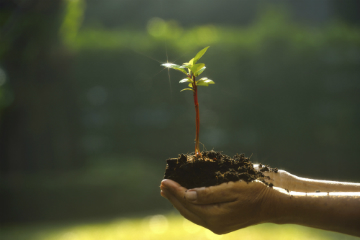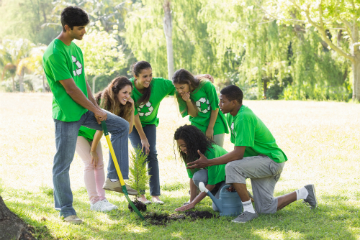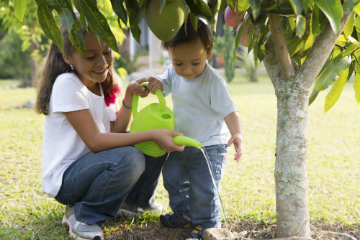National Arbor Week 2016
We all know we can't live without water, but we seldom give a second thought to the air we breathe. Trees and plants purify our air and provide us with oxygen, which is essential to almost all living creatures on our planet. The more trees we plant, the better the quality of air we breathe.
 South Africa celebrated its first Arbor Day in 1983, however, in 1999, the national government extended the day-long celebration to National Arbor Week to emphasise the importance of trees in our modern environment. National Arbor Week, which is celebrated from 1-7 September, intends to:
South Africa celebrated its first Arbor Day in 1983, however, in 1999, the national government extended the day-long celebration to National Arbor Week to emphasise the importance of trees in our modern environment. National Arbor Week, which is celebrated from 1-7 September, intends to:
- raise awareness of South Africa’s urban and rural greening initiatives,
- promote a better understanding of trees, particularly indigenous trees and fruit trees,
- highlight the important role that trees play in the sustainable development and livelihoods of people and their environment,
- highlight the role of trees in creating employment, especially in rural areas,
- highlight the role of fruit trees in addressing food security when integrated with other programmes, and
- encourage communities to participate in various greening activities within their own surroundings.
The theme for this year is “Forests and Water”, and the Department of Agriculture, Forestry and Fisheries (DAFF) want to motivate everyone to:
- protect our indigenous forests,
- help prevent veld and forest fires,
- plant a tree to green our country,
- mitigate against climate change,
- plant indigenous trees that save water,
- use water conserving methods when planting trees, and
- integrate fruit trees into your food gardens.
2016 Trees of the Year
To help increase public awareness of the more than 2 000 indigenous tree species in South Africa, every Arbor Week celebration will highlight specific trees: 1 common and 1 rare species.
The 2016 Trees of the Year are:
- Ficus thonningii (Common wild fig /Gewone wildevy)
- Maerua cafra (Common bush-cherry /Gewone witbos) and Maerua angolensis (Bead-bean tree / Knoppiesboontjieboom)
Greening our province
Greening refers to an integrated approach to the planting, care and management of all vegetation in urban and rural areas to secure multiple benefits for communities. Greening in the South African context takes place in towns, townships and informal settlements specifically because in the past, previously disadvantaged areas weren’t catered for in terms of planning for parks or planting trees in streets and open spaces.
Arbor City Awards 
2016 will mark the 14th year of the Arbor City Award competition, and to date a total of 30 municipalities have won awards in the competition. It’s a joint initiative between the DAFF in conjunction with the Institute of Environment and Recreation Management (IERM).
The main aim is to recognise and provide incentives for towns, cities and municipalities for their greening efforts, with the special focus on previously disadvantaged areas, such as townships and informal settlements.
The competition provides for 2 categories of winners namely the metropolitan municipalities and local municipalities. However, a new category namely “Rural Municipality with potential” will be introduced in the competition. This is done as an attempt to lure and encourage small, rural municipalities to enter the competition and engage in environmental and greening issues.
For each category, the winning municipality will receive prize money. The following municipalities have won the sought-after first prizes since 2012:
- 2012: Johannesburg Metropolitan Municipality (Gauteng)
- 2012: Khara Hais Local Municipality (Northern Cape)
- 2013: eThekwini Metropolitan Municipality (Kwa-Zulu Natal)
- 2013: Drakenstein Local Municipality (Western Cape)
- 2014: Stellenbosch Metropolitan Municipality (Western Cape)
- 2014: eThekwini Local Municipality (Kwa-Zulu Natal)
- 2015: Johannesburg Metropolitan Municipality (Gauteng)
- 2015: Hessequa Local Municipality (Western Cape)
Through this competition, municipalities are encouraged to undertake greening initiatives, develop greening plans, to expand greening projects in previously disadvantaged areas, ensure that municipalities comply with relevant legislation regarding greening and to raise awareness of the importance and value of greening in our communities.
This programme greens, educates, offsets carbon emissions and transforms schools and other community centres into healthier more sustainable environments. Food and Trees for Africa (FTFA) responds to applications for trees from communities living in barren, dusty townships and delivers trees with instructions on how to plant and maintain them. Millions of trees have been distributed to schools, clinics, old age homes, hospices, police stations and other community centres.
Million Trees Project
The Million Trees Project was launched during the 2007 Arbor Week campaign as part of the South African contribution to the United Nations Environment Programme “Plant for the Planet: Billion Tree Campaign”, where communities, industry, civil society organisations and governments are encouraged to plant at least one billion trees worldwide.
The purpose of the Champion Tree Project is to identify and protect trees that are of national importance and worthy of special protection, due to their remarkable size, age, aesthetic, cultural, historic or tourism value. Similar projects have been established in several other countries, but this is the first of its kind in Africa.
Nomination forms with guidelines for the nomination process are available from DAFF. Every nomination cycle starts on 1 August each year, and ends on 31 July the following year. 75 trees and groups of trees have been declared by the department as Champion Trees, based on criteria such as size, age and historical value.
Read more about the published Champion Trees lists for 2016.
Calculating your carbon footprint
Use this carbon calculator to measure your carbon footprint. You may be surprised at how high your footprint is!


